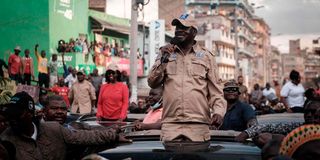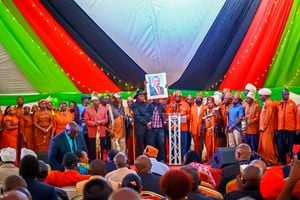Debunking Maandamano: A season of mayhem and metamorphosis

Opposition leader Raila Odinga.
Early in the week, Raila Odinga made history. He walked. As befits the larger-than-life would-be revolutionary son of Kenya’s founding vice president, Oginga Odinga, the walk was scrupulously televised, thanks to his retinue of minders, who sedulously oversaw the precise execution of this extensively scripted performance.
And so Odinga ambled by, alone in the focus of his photographers and videographers, as though surveying a deserted wasteland: devoid of all human presence except him. Thus sauntered Odinga, from his house to the matatu stage, where a vociferous menagerie of enthusiastic ‘wananchi’ awaited him, Azimio’s staple of slogans at the tip of their tongues.
Odinga was ushered into a matatu where a few well-known regulars from Odinga’s entourage materialised in full force, for a ride to the famous Ambassador terminus in Nairobi’s Central Business District.
According to Odinga, he chose to walk then ride a matatu in order to have personal experience of the struggles ordinary Kenyans endure as part of their daily life. During this ride, he had opportunity to confer with Kenyans who briefed him about their unbearable lives. So much so, that Odinga records that it was painful for him to hear their accounts in detail.
Landmark
The Ambassador terminus is so named because it is situated next to a towering landmark by way of the Hotel L’Ambassadeur, iconic in its weary glory. Odinga then proceeded to greet the statue of the assassinated political supernova Tom Mboya, on Moi Avenue, before paying similar compliments to the executed freedom martyr Dedan Kimathi on a likewise eponymous street not far away. This was the time it took for mobilised throngs of Azimio supporters to converge in the city and choke all semblance of productive normalcy out of it.
Odinga was in town to demonstrate to the government that utter mayhem and grief would engulf the streets of our towns and cities until his demands are met in full. Since then, coordinated chaos and violence have been unleashed at Odinga’s will, as though by remote control, throughout the country, and it is becoming clear that worse turmoil is in store, with more intense deployment of a robust and well-resourced strategy next week.
Onslaught
Three things are immediately clear from Odinga’s latest onslaught. The first, of course, is that the campaign to mobilise subversion, sabotage, looting, vandalism, delinquency and impunity on a nationwide scale is endowed with unprecedented levels of financial support and approved at the highest levels of Azimio La Umoja leadership, where Uhuru Kenyatta, our immediate former head of state is firmly perched as a silently transgressive leader.
Secondly, Azimio are desperately intent upon securing a Handshake by force, and reducing the government into another squabbling free-for-all, otherwise known as a grand coalition government, where friend and foe are unite in embezzlement and grand corruption.
Thirdly, Odinga is employing the wisdom of ‘mapema ndio best’ and getting his 2027 presidential campaign on the road. None of his colleagues have the capacity to notice that Odinga has shaken them off in order to embark, like aged Ulysses of legend, on a final sally.
Even though Odinga claims to have enjoyed ‘camaraderie’ with wananchi in the matatu, its entire cabin was filled to the brim with his associates. Although he claims to have been briefed so extensively on the travails of common people that he found it painful to hear, he also states that he chose on that day, to sample a brief moment of the daily struggles of ordinary wananchi. The image conjured up by this juxtaposition is obscenely messianic: the beloved son of a founding statesman deigning to descend into the world and experiencing the people’s sufferings in order to redeem them.
Manifesto
It also tells us that Odinga has not recovered from his tragically mistaken reaction to the Hustler Nation insurgency. He once patronised a restaurant operated by a self-styled fish monger and, upon learning of the youthful proprietor’s academic qualifications, undertook to find him a good job in an office, far away from such lowly trades.
While launching his manifesto, Odinga similarly derided mitumba - the imported used garments beloved of many a Kenyan - as “clothes that are worn by dead people”.
These effusions of toxic elitism and unmitigated contempt were most intensely directed at the rival campaign’s adoption of the wheelbarrow as their mobilising emblem. The idea of making the poor, vulnerable, marginalised and underserved visible in national policy discourse was condemned as takataka or rubbish.
In his own awkward ways, Odinga is frantically making amends, and recognises that proper atonement requires that he undertake a full political metamorphosis into a ‘hustler’ in order to claim some legitimacy as the champion of ordinary people and create a plausible rhetorical distance from the capitalist titans who have hitherto bankrolled him. In this metamorphosis, Uhuru Kenyatta must be feeling like Gregor Samsa, the travelling salesman who transmogrified into a mystifying insect in Franz Kafka’s Metamorphosis.
Mr Ng’eno is an Advocate of the High Court of Kenya.





